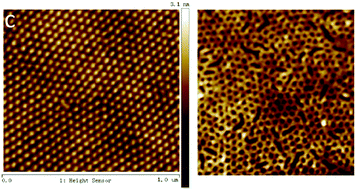Abstract
The separation of oil from water and filtration of aqueous solutions and dispersions are critical issues in the processing of waste and contaminated water treatment. Membrane-based technology has been proven as an effective method for the separation of oil from water. In this research, novel vertical nanopores membrane, via oriented cylindrical block copolymer (BCP) films, suitable for oil/water filtration has been designed, fabricated and tested. We used a ∼100 nm thick model poly(styrene-block-methymethacrylate) (PS-b-PMMA) BCP as the active top nanofiltration layer, processed using a roll-to-roll (R2R) method of cold zone annealing (CZA) to obtain vertical orientation, followed by ultraviolet (UV) irradiation selective etch of PMMA cylinders to form vertically oriented nanopores as a novel feature compared to meandering nanopores in other reported BCP systems. The cylindrical nanochannels are hydrophilic, and have a uniform pore size (∼23 nm), a narrow pore size distribution and a high nanopore density (∼420 per sq. micron). The bottom supporting layer is a conventional microporous polyethersulfone (PES) membrane. The created asymmetric membrane is demonstrated to be effective for oil/water extraction with a modestly high throughput rate comparable to other RO/NF membranes. The molecular weight dependent filtration of a water soluble polymer, PEO, demonstrates the broader applications of such membranes.



 Please wait while we load your content...
Please wait while we load your content...
